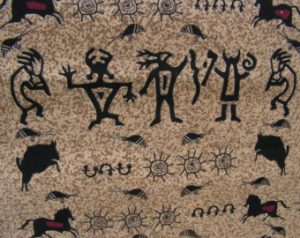Primitive culture
The first and the longest stage in the development of culture. It is correlated with the appearance of modern man and human society. The time frame of this period in the development of culture associated with the historical periods: ancient period of human history and culture is the Paleolithic era (800-13 thousand years BC), Mesolithic (13-6 thousand of years BC) and Neolithic (6-2 thousand years BC).
The first historical evidence of the appearance on Earth of man is the most primitive tools, the age of which, according to paleo-anthropologists – specialists who study the history of people, about 2 million years. The fact of the appearance of tools suggests that this period began the formation of man and humankind. However, only 50 and 30 thousand years ago Homo sapiens appeared (neoanthrope, CRO-magnon) man which could be considered a cultural being.

The main occupation of the Cro-Magnons were hunting, gathering and fishing, using stone, wood and bone tools. The technique used in their manufacture were already a better character associated with the secondary processing of raw materials (for example, the cleaved silicon wafers were polished and turned into scrapers, gravers, knives, etc.). In addition to caves and huts that were used as dwellings, were built from animal bones. Cro-Magnons made clothes from animal skins and plant materials. At this time there cave paintings, figurines and ornaments.
Afterwards, in the Mesolithic and Neolithic — perfected instruments of labor, is complicated funeral rites, indicating the presence of the cult of ancestors and belief in the afterlife, the first vehicle is a boat and skiing, originated in ceramics and weaving, but the main thing is that people have moved from hunting and gathering to agriculture and pastoralism, which resulted in the spread of sedentary lifestyle.
Based on the data of archaeology, Ethnography and linguistics can be described the main features of the primitive (ancient, archaic) culture — syncretism, anthropomorphism, tradition, social equality.
The syncretism of primitive culture means neuroscientist, the inseparability of the perception by the ancient people of the various phenomena of the world around and properties inherent in the people. Syncretism is manifested in the following forms:
The syncretism of society and nature. Primitive man perceived himself as an organic chatty of nature, feeling his kinship with all living beings, not distinguishing himself from the natural world;
The syncretism of the personal and the public. Primitive man identified himself with the community to which he belonged. “I” was replaced by the existence of “we” as a kind. The emergence of man in its modern form was associated with the displacement or replacement of identity that manifested itself only at the level of instincts;

- Syncretism of various spheres of culture. Art, primitive religion, medicine, agriculture, animal husbandry, crafts, foraging was not isolated from each other. Art objects (masks, figures, statues, musical instruments, etc.) has long been used mainly as the objects of everyday life;
- Syncretism as a principle of thinking. In the thinking of primitive man, there was no clear opposition between subjective and objective; the observed and imagined; internal and external; of the living and the dead; the material and the spiritual. An important feature of primitive thinking was syncretic perception of symbols and reality, word and object that this word refers to. So by using harm to the subject or image of a person was considered possible to inflict real evil. This has led to the emergence of fetishism — the belief in the ability of subjects to possess supernatural power. Special symbol of primitive culture was the word. Names seen as a part of a person or thing.
Anthropomorphism (from the Greek. Anthropos — man, morphed — form) is endowed with human qualities of objects and phenomena of inanimate nature, celestial bodies, plants and animals. Primitive man used nature in his image and likeness. In modern language, there are many idioms that create a picture of the world using human kind characteristics: for example, nature rejoices, the earth is tired, it is raining, and the clouds are floating, lightning strikes.
Traditionalism. In primitive culture had a special significance, as this tradition is the basis of stability and order that helped to organize community life, avoiding arbitrariness and chaos. For primitive culture was characterized by the hostility to innovation and dissent, which to some extent hindered the development of society.
Among the features of primitive culture includes the existence of social equality, based on the absence of private property and property inequality. In this regard, in primitive society, there was no political organization and government as its main element, and the culture of social relations built on the principles of community traditionalism.
The lack of writing meant that knowledge and skills could be transferred in this culture only through direct contact. The old, much-traveled people with a good memory is especially prized in this culture, because he was a “walking library”.